Montserrat Travel Guide
Welcome to the taste2travel Montserrat Travel Guide!
Date Visited: June 2018
Introduction
Feel like visiting a modern-day Caribbean Pompeii? The volcanic island of Montserrat offers a very different travel experience from the usual sun, sand and beaches.

The former Government House in Plymouth lies abandoned, destroyed by pyroclastic flows.
Like a phoenix rising from the ashes, tiny Montserrat is slowly dusting itself off after recent volcanic eruptions decimated the southern part of the island (including the capital Plymouth), covering large areas in ash, mud and other volcanic debris.

Trolleys, covered in volcano ash, remain where they were left in the former Angelo’s supermarket in Plymouth.
While the Soufrière Hills Volcano is far from dormant (there has been no considerable activity since 2012) Montserrat is open for tourism and visitors are once again returning to the island that, due to its rich Irish heritage, bills itself as the ‘Emerald Isle of the Caribbean‘.

This mud and ash filled bathroom at the former Montserrat Springs hotel is definitely out-of-order.
Montserrat is one of 14 British Overseas Territories, governed by a locally elected Premier and Parliament and is the only place outside of Ireland where St. Patrick’s Day is a public holiday (and the biggest festival of the year).

Inundated by pyroclastic flows, only the roof of this building remains visible.
Whilst the island has a few nice (black sand) beaches, the main draw today is ‘volcano tourism‘, with a highlight of any visit being a tour of the fascinating, abandoned capital of Plymouth, which lies entombed under many metres of volcanic debris, inside a restricted exclusion zone.

The former ‘Economy Bakery’ in Plymouth.
Plymouth remains the capital of Montserrat, making it the only ghost town that serves as the capital of a political territory.

Files and paperwork remain where they were left in an abandoned office in Plymouth.
Due to the ongoing volcanic threat, the southern two-thirds of the island lie inside a restricted exclusion zone, leaving residents and tourists with the lush, green, northern third of the island to enjoy.

An abandoned office in Plymouth.
The population of the island has dropped from 12,000 at the time of the eruption to 4,900 today, with many former residents taking up UK resettlement packages.

The concrete supports on the roof of the former government administration building in Plymouth were built to withstand a category 5 hurricane but the building was no match against a volcanic eruption.
For a period of ten years from 1979 – 1989, the island was a magnet for many famous musicians who came to record at the legendary AIR Studios Montserrat, which was created by Sir George Martin – the renown English record producer who signed The Beatles and produced every album they made until they disbanded (see the ‘Musical Legacy‘ section below for more).

A photo of Paul and Linda McCartney on Montserrat.
Location
Plymouth, Montserrat
Located in the Caribbean Sea, Montserrat is part of the Leeward islands. Its nearest neighbours are Guadeloupe (86 km) to the south-east, Antigua (55 km) to the north-east and Nevis (62 km) to the north-west.

Flying over the north-west coast of Montserrat.
History
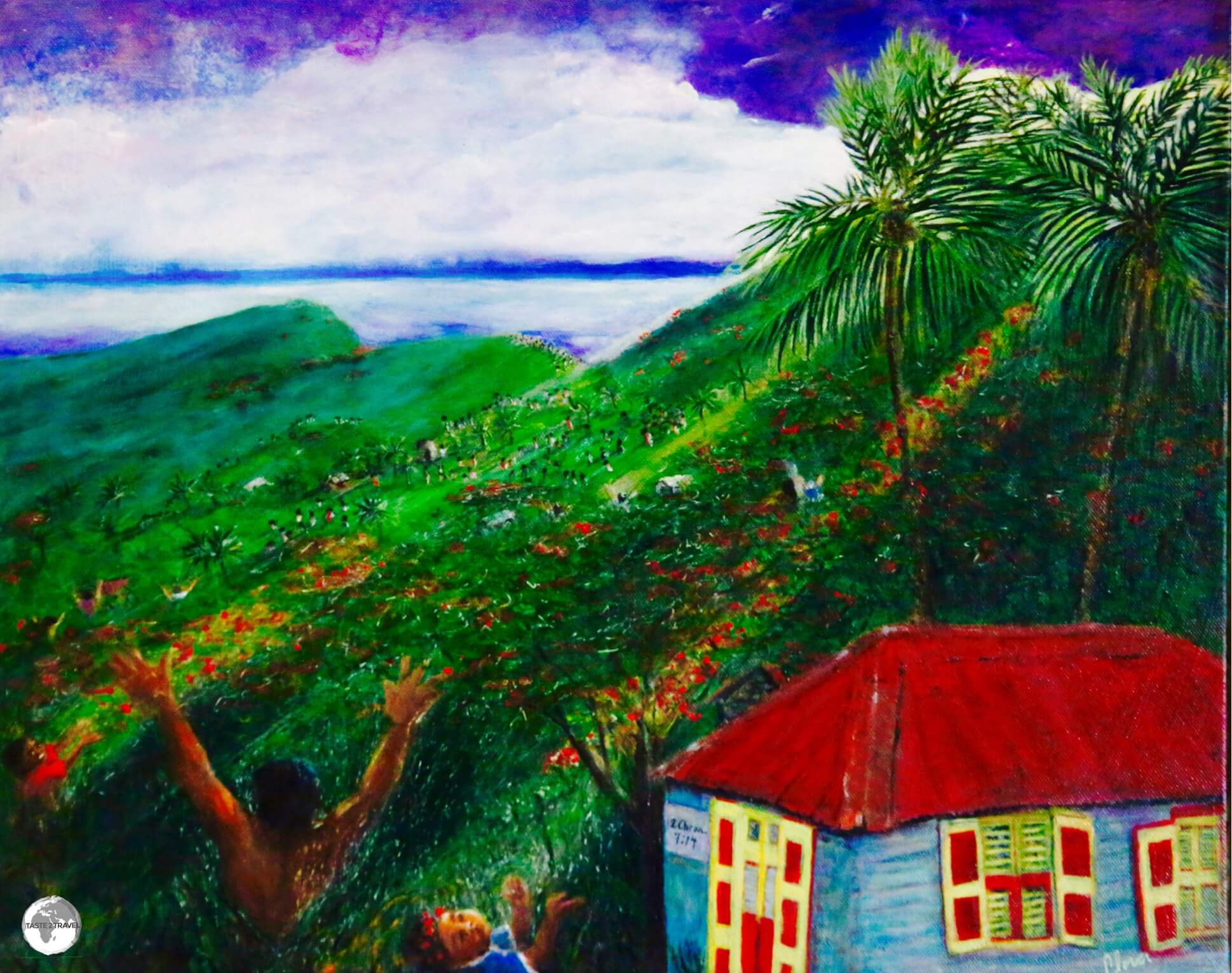
Artwork at the Hilltop Coffee House showing a typical Montserrat landscape.
Like neighbouring islands, the original inhabitants of Montserrat were native Arawak and Carib Indians who migrated up through the Antilles chain from South America. Archaeological digs in the Centre Hills area of the island have found evidence of human habitation extending back to 4000 BC.
As with every other island in the Caribbean, the first European to arrive was Christopher Columbus during his second voyage to the New World in 1493. Columbus named the island after the Virgin Mary and the Monastery of Montserrat, which is located in the hills outside of Barcelona, Spain.
Spain never attempted to take control of the island and it wasn’t until 1632 that the first Irish settlers arrived from neighbouring St. Kitts, some 80 km (50 miles) to the North. The Catholic settlers came to the island to escape Protestant intolerance and soon more Irish from Virginia joined the settlers. By 1648 there were ‘1,000 white families’ on the island, the vast majority of whom had a connection to Ireland.
The Irish established plantations and, being historical allies of France (and not being friendly towards the English), invited France to claim the island in 1666. The French took control but never sent any troops to protect the island, leaving it exposed to an English invasion, which took place later that same year.
Once the British gained control of the island, they imported African slaves to work on the various sugar plantations. Once slavery was abolished in 1833, a Quaker, Joseph Sturge, purchased a sugar estate on the island as part of his campaign to support freed slaves.

Souvenirs on sale at one of the few gift shops on the island.
More family members eventually joined him on the island and, in 1869, they established the Montserrat Company Limited, planting lime trees, which led to the commercial production of lime juice. They also established a school, and sold parcels of land to the inhabitants of the island.
From 1871 to 1958, Montserrat was administered as part of the federal crown colony of the British Leeward Islands. In 1958 it joined the short-lived West Indies Federation and, after the federation was dissolved in 1962, it became a Crown Colony.
Flag

The flag of Montserrat.
Being a British territory, the flag of Montserrat features the British Blue Ensign with the Montserrat coat of arms. The arms feature Erin, the female personification of Ireland, and the golden harp, another symbol of Ireland, all of which reflects the colony’s Irish ancestry.
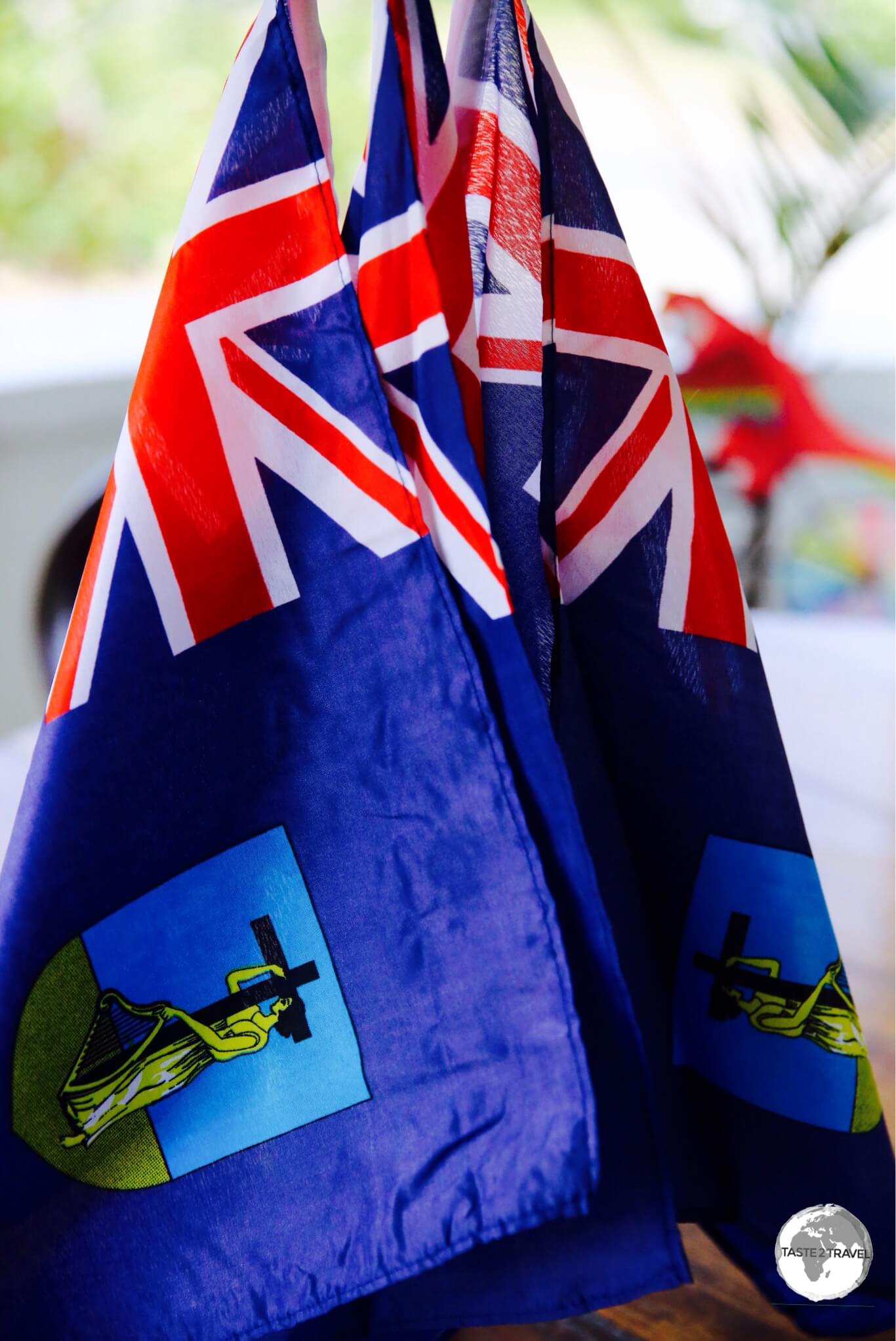
Montserrat souvenir flags on sale at the Hilltop Coffee Shop.
While the Montserrat flag can be seen flying over most parts of the island, the Union Jack can be seen flying outside the Governors Office in Brades (the new capital).

The Union Jack flying outside the Governors Office in Brades.
Natural Disasters
Hurricane Hugo
Two recent natural disasters have had a devastating impact on the island which was once a tourist playground. The first was in 1989, when Hurricane Hugo (a category five storm) slammed into Montserrat, damaging 90% of all structures on the island, including AIR Studios Montserrat, which was then abandoned. Hugo left 11,000 out of 12,000 people homeless and set back the tourist industry considerably.
Soufrière Hills Volcano

The Soufrière Hills Volcano is very shy and normally shrouded in cloud and, due to ongoing activity, access anywhere near it is strictly prohibited.
The second (more cataclysmic) natural disaster commenced in 1995 when, after a long period of dormancy, the Soufrière Hills Volcano became active.
The nearby capital, Plymouth, was evacuated in 1995 and was abandoned permanently in 1997 after it was burnt and mostly buried by a series of pyroclastic flows (a fast-moving current of hot gas and volcanic matter that moves away from a volcano reaching speeds of up to 700 km/h (430 mph) and temperatures of about 1,000 °C) and lahars (volcanic mud flows).
Exclusion Zones
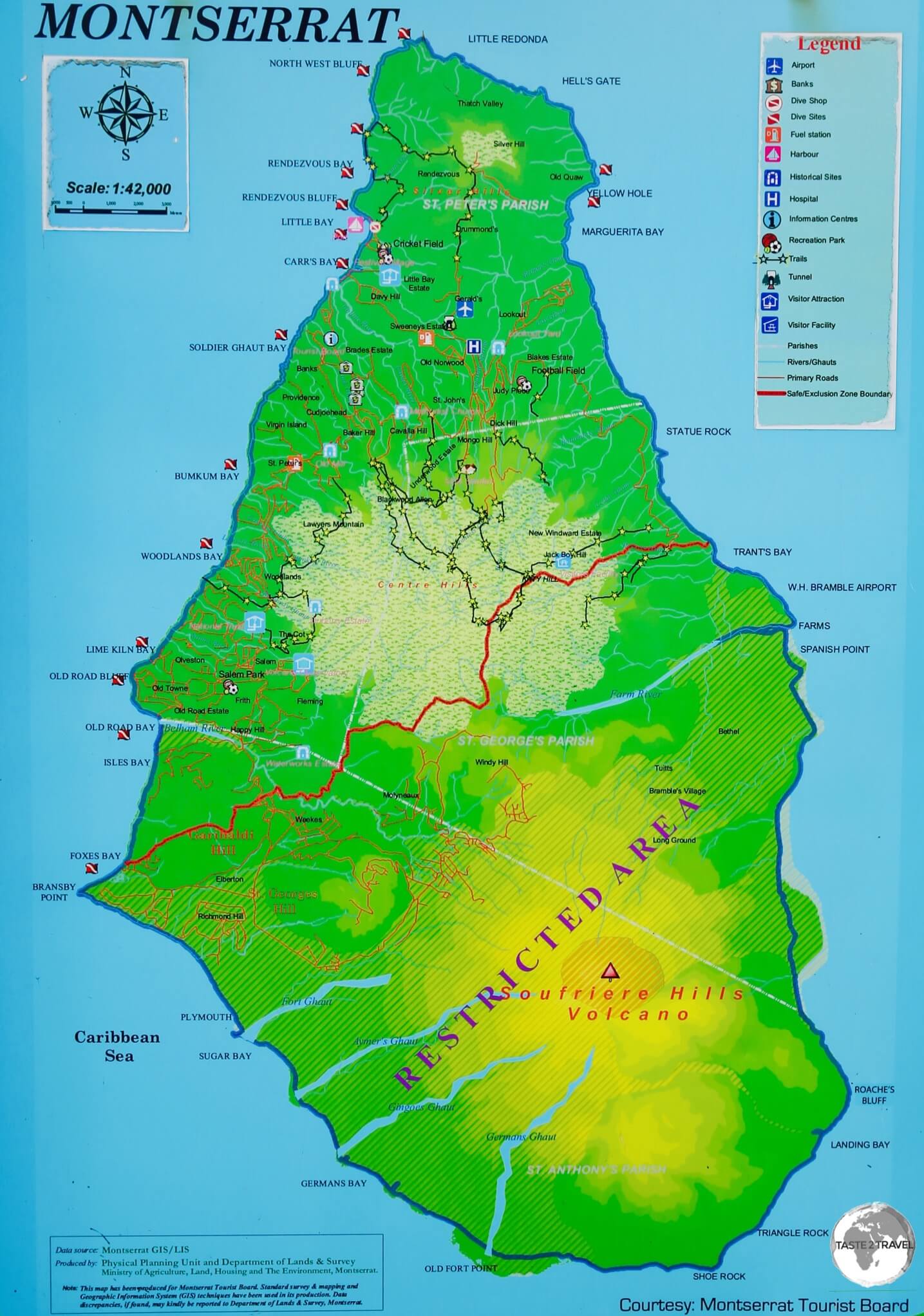
This map of Montserrat outside the airport terminal shows the Exclusion Zone.
While driving around the island, you need to be aware of the different Exclusion Zones. There are five defined zones, being A, B, C, F and V.

Roadside signs advise when you are entering a particular exclusion zone.
- Zones A & B: Open 24 hours and inhabited.
- Zone C & F: Open only during daylight hours and not inhabited.

The all important Zone V advisory sign is easily missed as it’s laying in grass on the side of the road.
- Zone V: The main exclusion zone, which includes the city of Plymouth. Strictly forbidden to enter (without an authorised guide) and if you are caught inside the zone without the correct permit you are subject to prosecution. Unfortunately the roadside sign which announces the demarcation line for Zone V is currently laying in long grass on the side of the road and is easily missed.
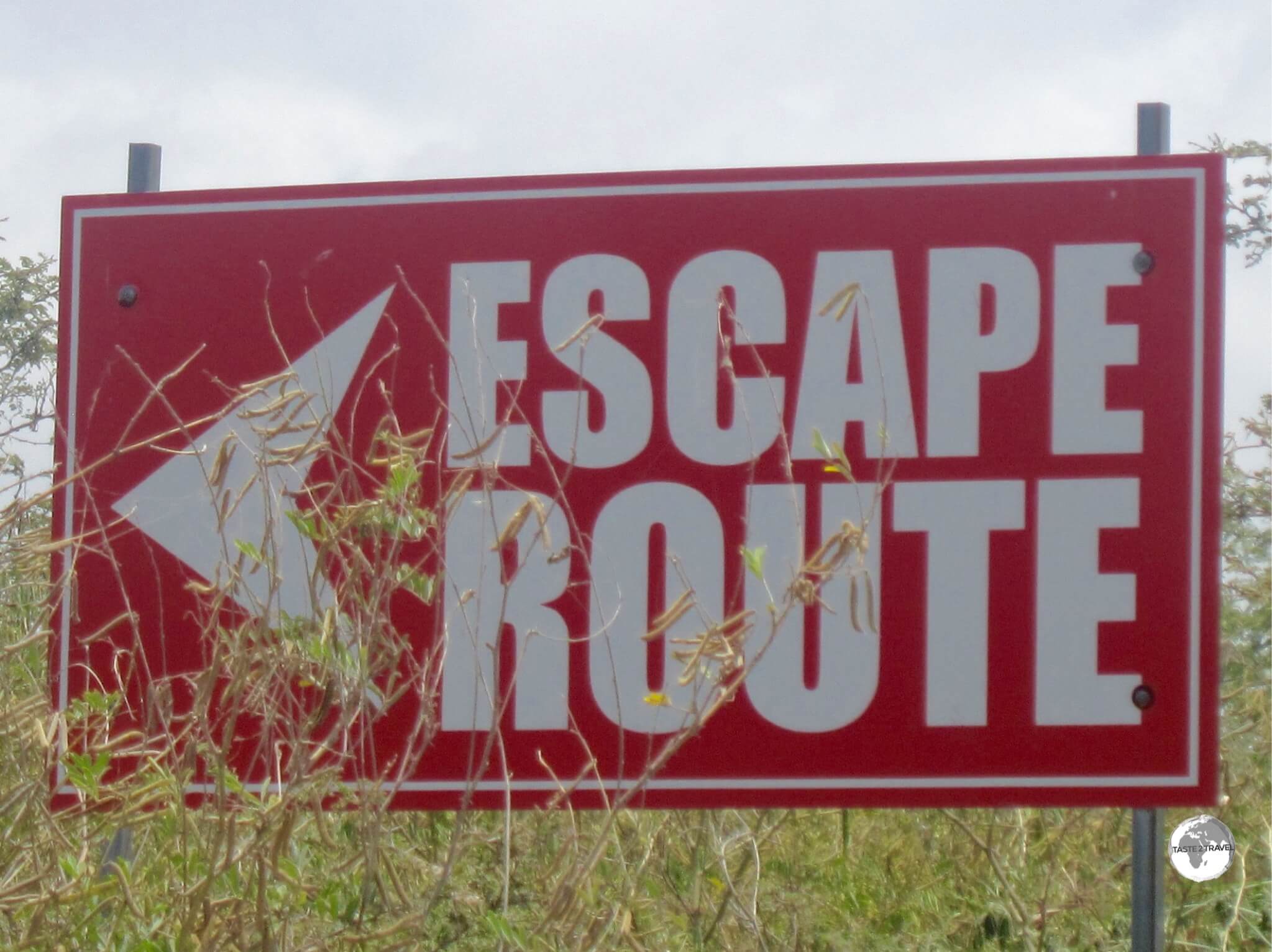
Important signage inside the exclusion zone on Montserrat!
Montserrat Volcano Observatory

The Montserrat Volcano Observatory (MVO).
Perched high on the side of a hill in the village of Flemmings, and with a clear view of the Soufrière Hills Volcano, is the Montserrat Volcano Observatory (MVO). Staff at the observatory use a variety of instruments (and a sleek helicopter) to continuously monitor volcanic activity.

Scientists at the Montserrat Volcano Observatory monitor the volcano using different means including a helicopter.
Musical Legacy
‘The Police’ recorded the video for ‘Every Little Thing She Does is Magic’ on Montserrat.
Tiny Montserrat has had a huge impact on the world of music and it’s all thanks to the vision of one man, renown English record producer, Sir George Martin. Known as “the 5th Beetle‘, Sir George decided quiet Montserrat would be an ideal place to create a 2nd ‘away-from-it-all’ recording studio where artists could come and focus solely on their music.
Opened in 1979, AIR (Associated Independent Recording) Studios Montserrat offered all of the technical facilities of its London predecessor, but with the advantages of an exotic location and over the next 10 years attracted a string of world-famous musicians such as:
- Boy George
- Dire Straits (who recorded ‘Brothers in Arms‘ at the studio)
- Duran Duran
- Elton John (who recorded ‘Too Low for Zero‘ at the studio)
- Eric Clapton
- Genesis
- Jimmy Buffet (who recorded the album ‘Volcano‘ while looking at the then-dormant Soufrière Hills Volcano from the studio)
- Little River Band
- Lou Reed
- Luther Vandross
- Michael Jackson
- Paul McCartney (who recorded the hit single ‘Ebony and Ivory‘ with Stevie Wonder at the studio)
- Sheena Easton
- Stevie Wonder
- The Police (who recorded ‘Ghost in the Machine‘ and ‘Synchronicity‘ at the studio)
- The Rolling Stones
- Ultravox

The abandoned AIR Recording Studios on Montserrat.
At least 67 albums were recorded at the studio until, like everything else on the island, it was severely damaged in 1989 by Hurricane Hugo and was abandoned. Today, this icon from the pop era is quietly rotting away in the tropical heat, surrounded by fencing and signs warning people not to enter.

A display, created by David Lea of the Hilltop Coffee House, illustrates the musical legacy from the days of the Air Recording studios.
You can learn more about the musical legacy of Montserrat from the informative displays which have been arranged by David Lea at the Hilltop Coffee House.

A display, created by David Lea of the Hilltop Coffee shop, shows some of the albums which were recorded at the Air Recording studios.
Arrow
While almost all musicians who recorded on Montserrat were from more distant lands, one artist – Alphonsus Cassell (aka Arrow), was a homegrown talent who found worldwide fame with his famous Soca music hit ‘Hot, Hot, Hot’.
Currency

My collection of Eastern Caribbean Dollars.
The currency of Montserrat is the Eastern Caribbean Dollar (EC$), which is issued by the Eastern Caribbean Central Bank, whose headquarters are on neighbouring St. Kitts. Since 1976, the exchange rate has been pegged to the US$ at a rate of US$1 = EC$2.70.
Besides Montserrat, the EC$ is also the currency of:
- Anguilla
- Antigua & Barbuda
- Grenada
- St. Kitts & Nevis
- Dominica
- St. Lucia
- St. Vincent and the Grenadines
The only ATMs available on the island are in Brades at the Royal Bank of Canada (all cards accepted) and Bank of Montserrat (only Visa accepted). Many places on the island do not accept credit cards.
The Great Montserrat Bank Robbery

A buried, blue concrete roof awning, is all that is now visible of the former Barclay’s Bank branch in Plymouth – scene of the great bank robbery.
In 1995, the reawakening of the Soufrière Hills Volcano sent pyroclastic flows and ash falls across a wide area of southern Montserrat including the capital, Plymouth. As the capital was quickly abandoned, a sum of nearly a million Eastern Caribbean dollars, worth about USD$300,000, was left laying in a bank vault at the Plymouth branch of Barclay’s Bank.
At some stage following the evacuation, locals – who had knowledge of the now buried treasure – returned to the bank premises, tunnelled through the volcanic rubble, then through the 20-inch reinforced concrete walls of the safe and stole the cash.
It took some time for the robbery to come to light and those implicated included a former bank employee and two local police officers. The Eastern Caribbean Central Bank, who belatedly reacted by cancelling a large range of Montserrat-registered bank notes (thereby leaving many people holding worthless pieces of currency) was criticised for its handling of the matter.
Philately

Stamps from Montserrat are popular with collectors around the world.
Like other small territories around the world, stamps issued by the Montserrat Post Office are popular with Philatelists word-wide. Currently the GPO (General Post Office) in Brades is operating out of temporary premises which are very claustrophobic and not worth visiting – unless you wish to feel like a sardine in a can.

The colourful fauna and flora of Montserrat are favourite subjects for stamp issues.
However, located on a breezy hill south of Brades (near Angelo’s supermarket), you’ll find the much more spacious and agreeable Montserrat Philatelic Bureau where the friendly staff (email: monphil@candw.ms) will happily assist you with your Philatelic needs. They previously operated a website (www.montserratstampbureau.com) but this is no longer available. The bureau is another branch of the post office and as such you can take care of regular postal business here without fighting the masses at the poky GPO.

The special commemorative booklet which was produced for the 30th Anniversary of the Philatelic Bureau.
To commemorate its 30th anniversary in 2006, the bureau produced a booklet which contains many pages of coloured photos of different stamp issues. This booklet is available from the bureau free of charge.
Sightseeing

View of the east coast of Montserrat from my FlyMontserrat flight.
Plymouth
The highlight of my visit to Montserrat was my tour inside the exclusion zone, which was conducted by the knowledgeable and informative Sun Lea, the owner of Montserrat Island Tours.

Touring the ruins of Plymouth with my guide, Sun, who always had radio contact with the MVO and the police.
The ruins of the capital can only be visited on a guided tour, conducted by a specially trained guide and requires the issue of a police permit.

A view of the buried capital. The white structure in the foreground is the rooftop terrace of a buried building.
Tours can remain in the city for one hour and during that time the guide is required to maintain constant radio contact with monitoring staff at the nearby Montserrat Volcano Observatory (MVO).

A photo of Plymouth in its heyday as the capital of Montserrat, before it was devastated by a pyroclastic flow.
Another requirement was that, even while walking about, the motor of our vehicle was always to be left running in case the MVO advised that we need to leave the area ASAP.

Trolleys remain where they were left at Angelo’s supermarket in Plymouth.
The half-day tour commenced at the Hilltop Coffee Shop (owned by Sun’s parents – David and Clover Lea), which was very convenient as I needed my morning coffee before going into the danger zone.

The former entrance to Angelo’s supermarket. A new branch has now opened in Brades.
The first stop was the Montserrat Volcano Observatory (MVO) where we had a view of the cloud-covered Soufrière Hills volcano and watched a documentary from the days following the initial eruption – most of the footage for which was filmed by David Lea.

Empty baby food bottles litter the ash-covered floor of Angelo’s supermarket.
From the observatory, we drove over the Pelham river into an eerie ash-covered landscape full of abandoned buildings. As we entered into Zone V, the exclusion zone, Sun contacted the local police patrol via radio to announce he was entering the zone “with four souls on-board“.

The ground floor of most buildings in Plymouth now lie below ground.
Plymouth was constructed on historical lava deposits in the shadow of the volcano and was evacuated when the volcano resumed erupting in 1995 and was abandoned permanently in 1997 after it was burnt and mostly buried by a series of pyroclastic flows and lahars.

Pyroclastic flows and lahars inundated Plymouth with ash, mud and huge rocks.
After touring Plymouth we drove to a nearby former residential neighbourhood where we visited the ruined Montserrat Springs hotel – once one of the island’s finest.

The abandoned office at the Montserrat Springs hotel.
Like a cake dusted with icing sugar, the entire property is coated in volcanic ash and is entered through the reception where paperwork and a calculator still remain on the desk.

Valisha waiting a long time to check in at the Montserrat Springs hotel.

A calculator and ledger book remain on the reception desk of the abandoned Montserrat Springs Hotel.
Once past reception we visited the former pool area which has now been filled with volcanic mud as have all the rooms on the ground floor.

A ‘before and after’ photo of the pool area at the Montserrat Springs hotel.
In all the rooms, bedside lights remain attached to the walls (but now just inches off the new ground level), shower curtains and other bathroom fittings remain in place as do buried dressing tables and wardrobes. Walking the corridors of the old hotel was indeed eerie.
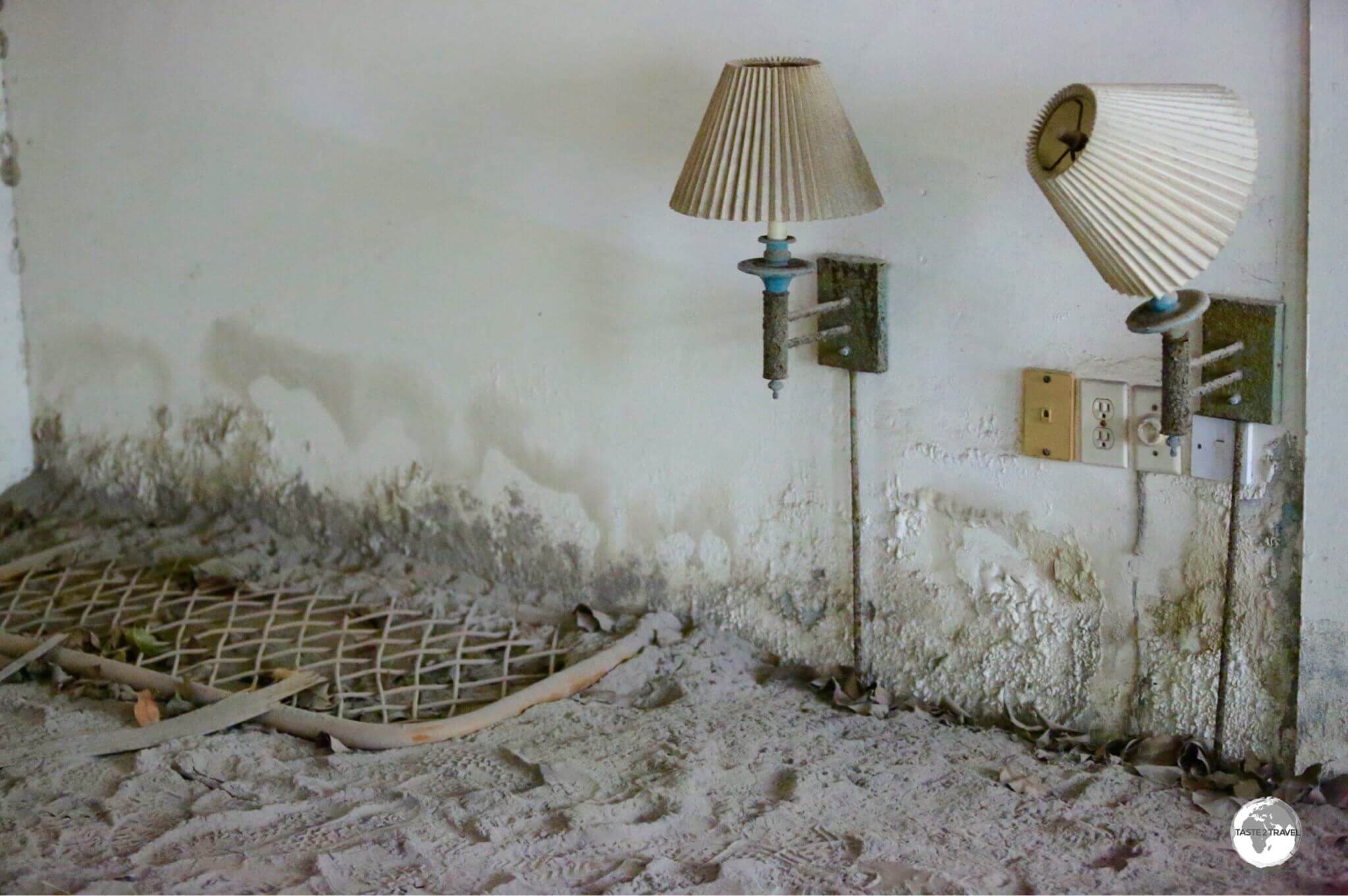
An old bedhead and bedside lights, which are now just above the new ground level at the Montserrat Springs hotel.

Buried furniture, entombed in the former rooms of the Montserrat Springs hotel.

All the ground floor rooms at the former Montserrat Springs Hotel have been inundated with volcanic ash and mud.
Garibaldi Hill

A view of Plymouth from Garibaldi Hill shows the path cut through the capital by the pyroclastic flows and lahars.
After crossing the Belham river, a steep, narrow, unmarked road leads to the top of Garibaldi Hill from where you have sweeping views of the southern part of the island, including the buried capital of Plymouth and the Soufrière Hills volcano, which looms over everything on this part of the island.
Montserrat National Trust

Artwork at the Montserrat National Trust.
The Montserrat National Trust is tasked with preserving and conserving the cultural, historical and archaeological heritage of the Island. Located on the main road in Olveston, the trust headquarters features a modest botanical garden, the Oriole gift shop (named after the national bird), a cafe (closed at the time of my visit) and historical and cultural displays.

A display at the Montserrat National Trust shows a glass bowl, bent out of shape by the heat of the pyroclastic flow which devastated Plymouth.
Runaway Ghaut

According to local legend, taking a sip of water from ‘Runaway Ghaut’ will ensure you return to Montserrat.
Located on the side of the main road south of Woodlands, is this natural gorge which is fed by a fresh water spring. Local legend has it that if you drink from here you will return to Montserrat. Interestingly the locals mispronounce the name as ‘runaway gut‘.
Woodlands Bay
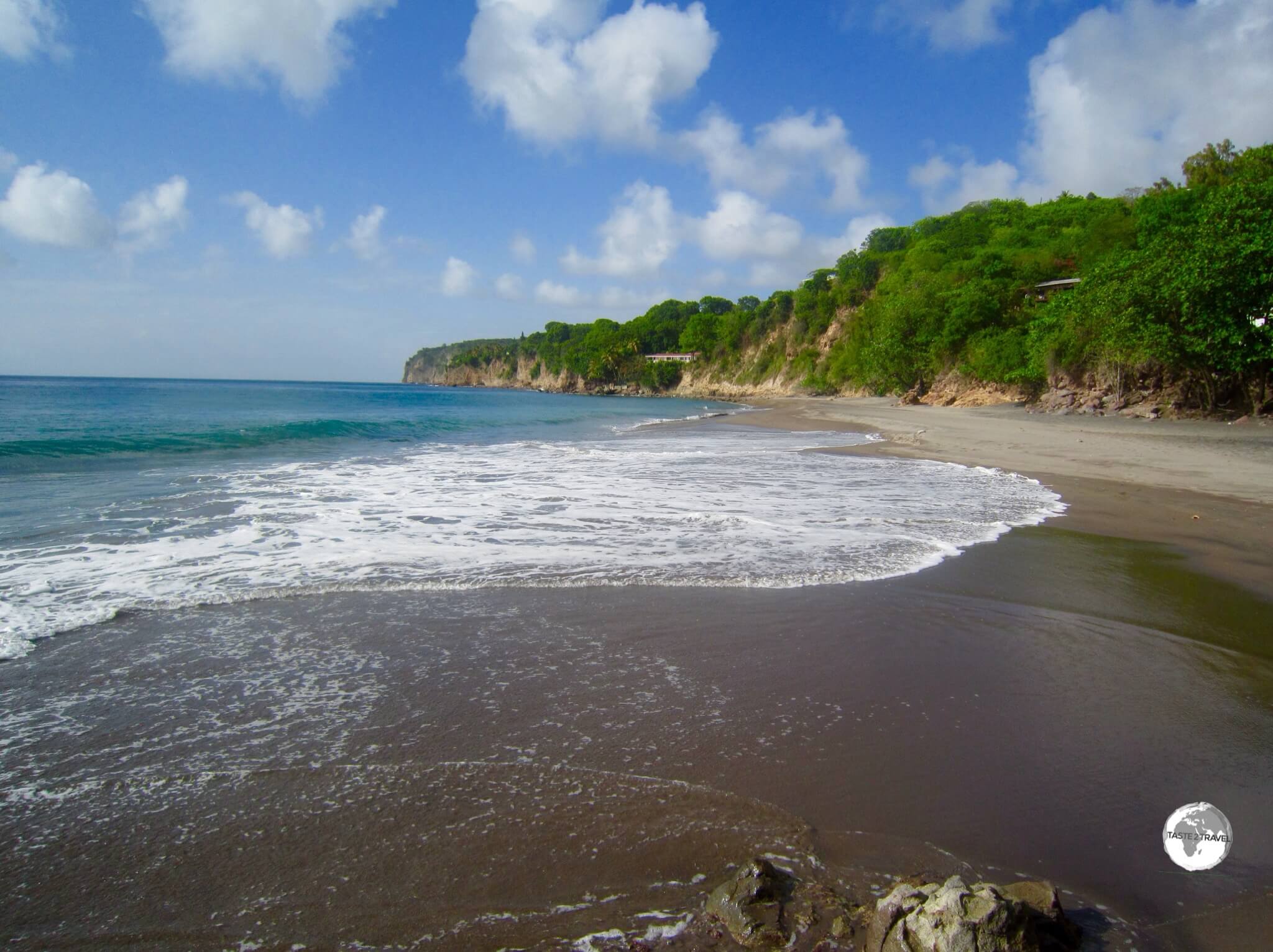
Who needs a white-sand beach? Montserrat offers many beautiful volcanic-sand beaches such as Woodlands Bay.
This beautiful, black-sand beach, lies at the bottom of a steep, windy road and is often deserted. If you wish to snorkel there are a couple of reefs off the northern end of the beach.
Little Bay

Little Bay offers ideal swimming on a beautiful black-sand beach and great sunset views.
Located at the top of the west coast next to the ferry dock, Little Bay offers a nice black-sand beach, beautiful sunsets and a couple of restaurants/ bars (see the ‘Eating Out‘ section for more).
This has been designated as the new capital of Montserrat and is currently a work-in-progress. The National Museum of Montserrat is located here but has limited opening hours so best to call ahead.
Silver Hills

The panoramic view south from Silver Hills with the new settlement of ‘Lookout’ in the foreground and the remnants of a pyroclastic flow in the background.
Located at the top of the island and accessed via a very steep, one lane (but two-way) road behind the airport, Silver Hills affords panoramic views over the northern part of the island, including the new airport, the new settlement of Lookout, the east and west coasts and the Centre Hills and beyond.
Jack Boy Hill

A view into the exclusion zone from the Jack Boy Hill lookout. The old airport, W. H. Bramble, lies buried in the rubble below.
At the end of the road on the east coast is this lookout which provides panoramic views into the exclusion zone. The former airport, W. H. Bramble, lies buried under the huge pyroclastic flow directly below the hill.
Accommodation

A sweeping view of the west coast of Montserrat from the Gingerbread Hill Guest House.
There are just two hotels on Montserrat but many more guesthouses, B&B’s and apartments, all of which are listed on the Accommodation page of Visit Montserrat.
Gingerbread Hill
While on the island, I stayed at the wonderful Gingerbread Hill, which is owned by Clover and David Lea who are the creative force behind the nearby Hilltop Coffee Shop.

The Gingerbread Hill Guest House on Montserrat.
Perched on top of an exposed, breezy hill (no air-con needed!), the guest house offers four spacious apartments with the top-floor, Heavenly Suite, offering unbeatable views of the island and beyond.
By day you have stunning, uninterrupted, panoramic views of the mountains, rain forest and the sea (including the distant island of Nevis – i.e. St. Kitts & Nevis) and at night, incredible star-gazing from the private rooftop terrace (zero light pollution) and views of the lights of Nevis.

A friendly Green Anole lizard at Gingerbread Hill.
Clover and David can arrange car rental, airport transfers and tours of Plymouth and the Exclusion Zone, which are conducted by their son – Sun – through his company – Montserrat Island Tours (highly recommended).

The views from the ‘Heavenly Suite’ at the Gingerbread Guest house truly are heavenly.
Source: Gingerbread Hill Guest House.
Eating Out

Bee Bee’s Bakery in Brades.
For an island of 4,900 souls, Montserrat offers a surprisingly good selection of dining options, serving everything from unpretentious local cuisine to more refined fine dining. A full list of dining options is available on the Visit Montserrat website while here I’ve listed some of my personal favourites (ordered from north to south).

Little Bay is home to Time Out Bar & Restaurant which is a great place to have a drink while watching the sunset.
Time Out Bar & Restaurant
At the northern end of the island, Little Bay is an ideal place to watch the sunset and it’s here you’ll find the beach-side Time Out Bar & Restaurant. Offering American favourites (burgers, barbecued ribs, wings etc) – I recommend their fresh Fish ‘n’ Chips. Their bar is one of the few places on the island where you can get a drink in the evening.
The People’s Place
Located south of Brades on Fogarty Hill, you’ll find a local culinary institution, which is housed inside a very simple turquiose-blue shack – The People’s Place. The host (John) prepares great tasting, simple Caribbean fare which is always served with a big smile (his roti are especially good). If you’re in town on Friday, this is the place to try Goat Water – a stew featuring goat meat which is the national dish.
Hilltop Coffee House

The Hilltop Coffee House at Fogarty Hill.
Directly next door to The People’s Place is the Hilltop Coffee House which is a must for anyone visiting the island. The cafe is a not-for-profit which was founded (and is run by) the energetic David Lea and his wife Clover (who also run the nearby Gingerbread Hill Guesthouse). Clover bakes the best brownies on the island and David brews a mean cup of coffee.

A wall display at the Hilltop Coffee House.
David has turned the cafe into a museum which covers all aspects of life on Montserrat from its musical heritage to the eruption of the Soufrière Hills Volcano (which David filmed and is available for purchase on DVD) to local art and much more.
David is known as Mr Volcano and filmed the entire eruption. You can purchase his DVD – The Price of Paradise – at the coffee-house.

Signs salvaged from Plymouth businesses are displayed at the Hilltop Coffee House.
An American native, David is very informative and enthusiastic about the island, offering visitors a free tour and explanation of his extensive collection of memorabilia.
If there’s one place on the island from which you can gain an understanding of everything Montserrat, it’s the Hilltop Coffee House.
Olveston House

Olveston House, the former winter residence of Sir George Martin.
If you’re looking for a fine dining experience, you’ll find it at Olveston House, the former winter residence of Sir George Martin, who purchased the estate in the early 1980’s. For many years, Olveston House hosted famous artists such as Sting, Eric Clapton, Elton John and Paul McCartney who came to Montserrat to record at AIR Studios.
It’s worth excusing yourself to use the toilet while dining here just to view the old black and white photos of Paul and Linda McCartney and John Lennon which line the hallway. Offering Caribbean-infused international cuisine, the restaurant is open for breakfast, lunch, dinner and ‘high tea’ with meals served on the breezy balcony, overlooking the garden.
LIAT Airline
From Olveston House to the Caribbean

If you’re spending anytime travelling around the Eastern Caribbean, there’s a good chance you’ll end up on a flight operated by the region’s dominate carrier – LIAT (Leeward Islands Air Transport). LIAT was founded in the 1950’s by Sir Frank Delisle from neighbouring St. Kitts, who lived at Olveston House and was the Managing Director of the Montserrat Company.
In 1953, the first flight touched down on the airstrip at Olveston House and LIAT airlines was born. Today LIAT serves 17 destinations throughout the region, including Guyana in South America.
The Attic

The Attic cafe serves up tasty local food and has the best homemade ginger beer on the island.
Housed in a cute wooden cottage, around the corner from Olveston House, is another local favourite – The Attic. Open for breakfast and lunch only, this cafe serves local fare (I especially recommend the grilled fish with rice and salad) and fresh juices, all of which are made in-house. The homemade ginger beer is especially good – so good I had to order a 2nd glass!
Visa Requirements

The clover leaf is an appropriate passport stamp for the Emerald Isle.
As a British Overseas Territory, Montserrat maintains its own visa policy, which you can check here.
It’s appropriate that the passport stamp to the Emerald Isle is a green clover leaf.
Getting There
Air

Boarding the FlyMontserrat flight at Antigua airport.
All flights into Montserrat arrive at the small John A. Osborne Airport which is located in the village of Gerald’s. Constructed at a cost of approximately US$18.5 million, the airport was opened in July of 2005 by Princess Anne and was built as a replacement for the former airport – W. H. Bramble – which was completely destroyed in 1997 as a result of the eruption of the Soufrière Hills volcano.
Between 1997 and 2005, Montserrat had only been accessible by helicopter, boat and seaplane.

The terminal at John A. Osborne Airport on Montserrat.
The airport has the distinction of being the only one in the Caribbean with a public road tunnel under its runway and is the base for FlyMontserrat Airways which flies three times a day between Montserrat and neighbouring Antigua (the only destination for flights to/from the island), with the 57 km hop taking 20 minutes in nine seater Britten-Norman Islander aircraft.

On final approach to John A Osborne airport, Montserrat.
The following airlines provide services to Montserrat:
- SVG Air – flies to/ from Antigua
- FlyMontserrat Airways – flies to/ from Antigua
Airport Taxes
Antigua Airport is the only gateway for flights to/ from Montserrat and if you’re staying on Antigua more than 24 hours, you will be required to pay an arrival tax of US$37.50 and also a departure tax of US$37.50 (a total of US$75 in taxes!).
Most airlines automatically include these horrendous taxes in their tickets, however FlyMontserrat annoyingly does not!
When you depart for Montserrat from Antigua, you’ll be required to pay the Antigua departure tax (cash or credit card) at the time of check-in.
When departing Montserrat, you’ll be required to pay the Antigua arrival tax (cash or credit card) at the time of check-in.
You’re also required to pay the Montserrat departure tax (cash only) which is EC$45 per person. It would be so much easier if FlyMontserrat followed the example of all other airlines and included these taxes in its tickets.
Sea

The Antigua-Montserrat ferry, Jaden Sun, docked at Little Bay.
A regular ferry service operates five days a week between Port Little Bay in Montserrat and Heritage Quay Pier in Antigua with the 52 km crossing taking 90 minutes on the fast boat – Jaden Sun.
If you ever spent time in Saint Vincent & the Grenadines, you might recognise this boat as being the old inter-island ferry which was once captained by the famous Captain Elvis and connected the Grenadines to the main island of St. Vincent on a daily basis.
I’d always wondered where this boat (which was a lifeline for the Grenadines) had disappeared to and was very surprised to see it in its new role as the Antigua-Montserrat ferry.

An advertisement announces a day trip to neighbouring Guadeloupe on the Jaden Sun.
The ferry company also operates occasional charters to neighbouring St. Kitts, Nevis and Guadeloupe. You can view the current schedule and fares on the Montserrat Access Division Facebook page and you can make bookings on this website.

A view of the Jaden Sun, en-route from Antigua to Montserrat, cutting a path across giant Sargassum seaweed blooms.
Getting Around
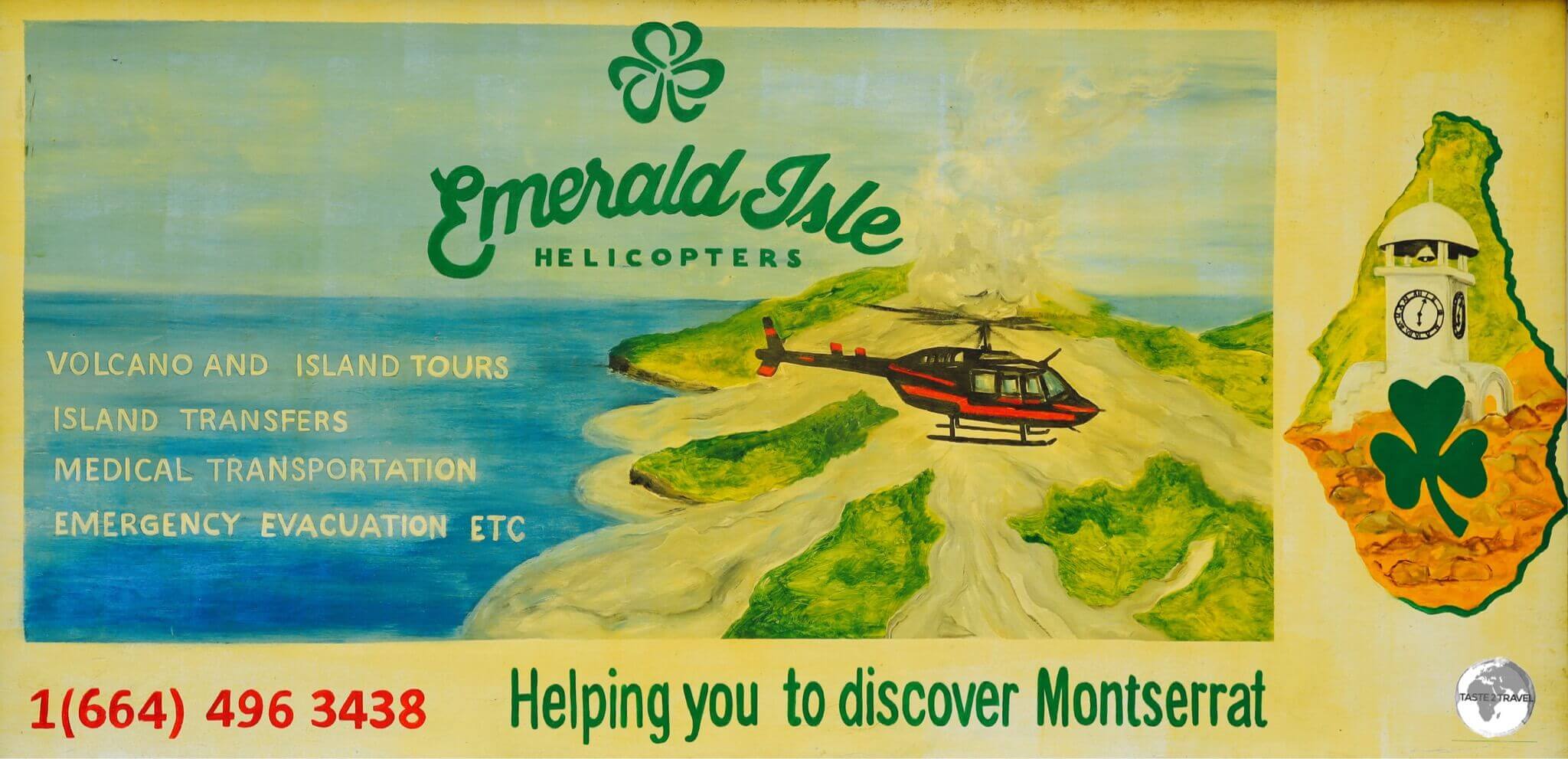
Scenic flights over Montserrat can be arranged by helicopter.
Bus
A small fleet of mini-vans shuttle back and forth along the one main road, during daylight hours and to no fixed schedule, stopping wherever required, charging a fare of EC$3.
Taxi
There are approximately 30 taxis on Montserrat, all of whom are easily identifiable by their green license plates beginning with the letter ‘H‘. Taxis are available at the boat dock, airport or can be booked through your accommodation provider. You can view a complete listing of taxi operators on the Visit Montserrat website.
Rental Car
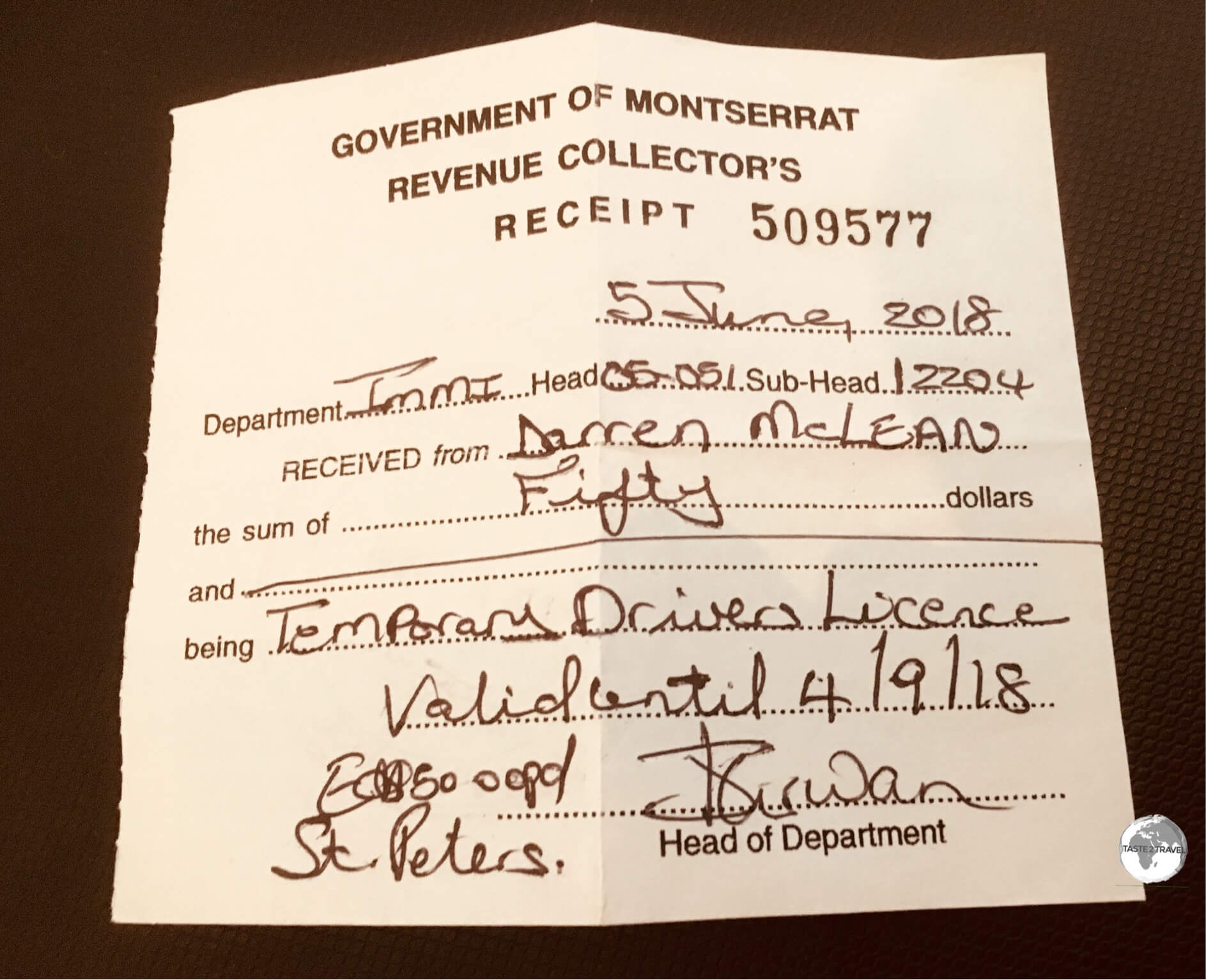
My temporary Monserrat drivers license.
Your best option for exploring Montserrat is to hire a car, most of which are aging 4WD vehicles, which are ideal on the tough island roads. Although none of the international car rental chains are represented, you can organise car hire through your accommodation provider or from the complete list of operators on the Visit Montserrat website.
If driving, you’ll need to purchase a temporary local Drivers License (EC$50/ valid for 90 days) from the immigration officer at the airport (if you’re collecting your car upon arrival) or a police station elsewhere.
It’s easy to know who the tourists are on the island, as all rental vehicles have special red license plates beginning with the letter ‘R‘. The roads are steep, narrow and full of hairpin turns but traffic is light and there are no traffic lights on the island. With just one main road meandering through the northern half of the island, navigation devices are definitely not required.
That’s the end of my Montserrat Travel Guide.
Safe Travels!
Darren
Follow me on Instagram:
[instagram-feed feed=1]
Further Reading
Other travel reports from the Caribbean region include:
- Anguilla
- Antigua & Barbuda
- Aruba
- Bahamas
- Barbados
- Bonaire
- Bermuda
- Cayman Islands
- Cuba
- Curaçao
- Dominica
- Dominican Republic
- Grenada
- Guadeloupe
- Haiti
- Jamaica
- Martinique
- Montserrat
- Puerto Rico
- Saba
- Saint Barthélemy (Saint Barts)
- Saint Eustatius (Statia)
- Saint Kitts & Nevis
- Saint Lucia
- Saint Martin/ Sint Maarten
- Saint Vincent & The Grenadines
- Trinidad & Tobago
- Turks & Caicos
- Virgin Islands (British)
- Virgin Islands (U.S.)
Montserrat Travel Guide Montserrat Travel Guide Montserrat Travel Guide Montserrat Travel Guide Montserrat Travel Guide Montserrat Travel Guide Montserrat Travel Guide Montserrat Travel Guide Montserrat Travel Guide Montserrat Travel Guide Montserrat Travel Guide Montserrat Travel Guide Montserrat Travel Guide Montserrat Travel Guide Montserrat Travel Guide Montserrat Travel Guide
Author: Darren McLean
Darren McLean is an Australian, full-time, digital nomad who has spent 37 years on a slow meander around the globe, visiting all seven continents, 192/ 193 UN countries and 245/ 251 UN+ countries and territories.
He founded taste2travel to pique one’s curiosity and inspire wanderlust.








je vais visiter Montserrat en février 2023 et te remercie pour ton fabuleux guide et commentaires
Merci beaucoup pour tous ces renseignements; bravo
Bonjour Christian!
De rien! Profitez de Montserrat.
Darren
This is an awesome and accurate description of Montserrat. We came back after 30 years for 2 weeks Christmas 2023. It is more than dead.Not one person in the shops,beaches or restaurants on Christmas and many other days. Salem Day was nice but road march had less than 200 people I think. Taxi rates were not adhered to by taxi drivers and I got a bad attitude from two of them because they tried to charge $20 or $50 US for a $15 EC ride. Groceries very expensive. $395 US for very basic low quality brands of food for 10 days for 2. Victors is better store than Rams or Angelo’s. AirBNB was great! $1600 for a house w 3 bedrooms and 2 baths, no pool though, for 2 weeks. Again plan on paying taxis for store runs, beach, bars, restaurants, local events. We enjoyed the soca and calypso very much along with seeing old friends and a tranquil relaxing time away from the rest of the world.
Hello,
Thank you so much for your feedback. I trust you enjoyed your time on Montserrat.
Wishing for all the best for 2024 and safe travels .
Regards,
Darren